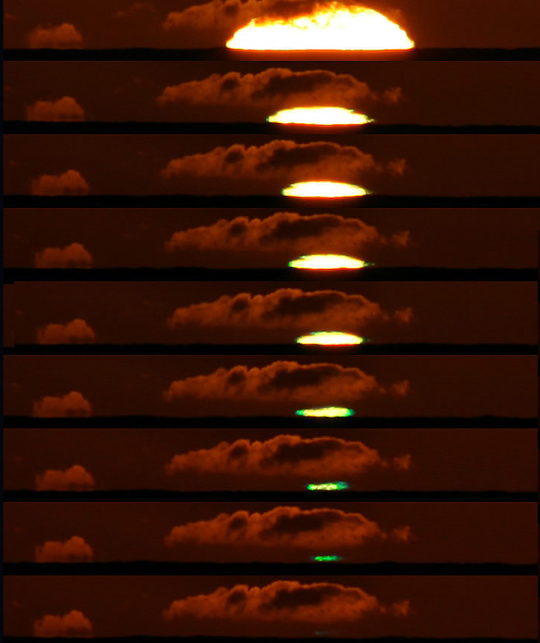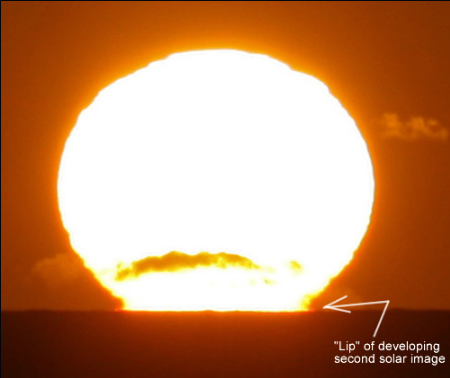OPOD - Green Flash
OPOD - Green Flash: Exploring the Phenomenon in Detail
Green flashes are a captivating atmospheric optical phenomenon that occur during sunsets or sunrises. They are characterized by a brilliant emerald green color that appears just as the last sliver of the sun disappears below the horizon. While there are different types of green flashes, the classical green flash is the most sought after and visually striking. However, other types of green flashes may be more frequently photographed.
One type of green flash, known as the inferior mirage green flash, occurs as a result of a specific atmospheric condition. It is produced by a layer of ocean-warmed air beneath cooler air. As the low slanting rays of the sun reach our eyes, they can travel along two paths: an upper path and a lower path.
The upper path is minimally influenced by temperature gradients between the hot and cold air, resulting in a "normal" upright image of the sun. On the other hand, the lower path experiences stronger refraction at the boundary between the hot and cold air. This causes the ray to curve back upwards towards the colder and denser air, giving the appearance that it is coming from a lower position. Consequently, an inverted image of the sun forms beneath the first image.
As the sun sets and its images draw closer together, refraction at grazing angles becomes highly sensitive to both the sun's elevation and its color. This sensitivity leads to vertical magnification, which intensifies color separation and ultimately produces the striking green flash.
To identify the classical green flash, it is essential to observe certain signs or indicators. One such sign is a mirage, which can be identified by a distinctive "lip" on the sun's disk as it gets lower on the horizon. Additionally, a choppy horizon that appears to be the actual horizon is often an illusion created by the lower edge of the mirage.
The phenomenon of green flashes during sunsets and sunrises is a captivating subject for photographers and enthusiasts alike. It offers a unique opportunity to witness the interplay between light, atmosphere, and perception. By understanding the underlying atmospheric conditions and optical processes involved, we can better appreciate the beauty and rarity of green flashes.
In conclusion, green flashes are a fascinating atmospheric optical phenomenon that occur during specific sunset or sunrise conditions. The classical green flash, characterized by its brilliant emerald green color, is the most sought after and visually striking type. It is caused by an inferior mirage of the setting sun, which in turn is produced by a layer of ocean-warmed air beneath cooler air. By observing signs such as the presence of a mirage and a choppy horizon, one can increase their chances of witnessing this captivating event. Green flashes serve as a reminder of the complex interactions between light and the atmosphere, offering a glimpse into the wonders of our natural world.

Two Green Flashes
Green flashes seen during consecutive sunsets by Rob Kaufman. Location - Southern Pacific near Tonga 6th and 7th July '11.
©Rob Kaufman, shown with permission.


These flashes, a brilliant emerald green almost touching the horizon as the last sliver of sun disappears, are the much searched and wished for classical green flash. Other types of green flash are far less obvious visually although they are photographed more often.
The flashes here are the result of an inferior mirage of the setting sun. In turn the mirage is produced by a layer of ocean warmed air beneath cooler air.
The low slanting sun's rays can reach the eye along two paths. The upper path is hardly influenced by the temperature gradients between the hot and cold air. It produces a "normal" upright" sun image.
The lower path is refracted more strongly at the hot - cold boundary zone. The ray is curved back upwards towards the colder and denser air. The ray appears to the eye to be coming from lower down. It produces an inverted image of the sun beneath the first image. Neither image is more or less "real" than the other.
As the sun sets the two images draw closer together and at that point the refraction at grazing angles becomes very sensitive to the sun elevation and to colour. There is - in essence - vertical magnification. This magnification produces the strong colour separation - the green flash.

The classical green flash requires a mirage. As the sun gets lower look out for the signs of one - a lip on the sun's disk.
Another sign is a choppy horizon that is actually not the horizon at all but is the lower edge of the mirage.
Note: this article has been automatically converted from the old site and may not appear as intended. You can find the original article here.
Reference Atmospheric Optics
If you use any of the definitions, information, or data presented on Atmospheric Optics, please copy the link or reference below to properly credit us as the reference source. Thank you!
-
<a href="https://atoptics.co.uk/blog/opod-green-flash/">OPOD - Green Flash</a>
-
"OPOD - Green Flash". Atmospheric Optics. Accessed on November 26, 2024. https://atoptics.co.uk/blog/opod-green-flash/.
-
"OPOD - Green Flash". Atmospheric Optics, https://atoptics.co.uk/blog/opod-green-flash/. Accessed 26 November, 2024
-
OPOD - Green Flash. Atmospheric Optics. Retrieved from https://atoptics.co.uk/blog/opod-green-flash/.